Content
- Classification of the disease
- Stages and degrees
- Symptoms and Signs
- Causes
- Diagnostics
- Treatment methods
- Drug therapy
- Folk remedies
- Physiotherapy
- Operation
- Potential consequences and complications
- Video about joint periarthritis
Periarthritis of the knee joint characterized by an inflammatory process that affects the surrounding tissues around the joint of the lower limb in the knee area. Pathological processes provoke numerous adverse factors. Periarthritis is accompanied by pronounced symptoms and requires complex treatment, without which the patient risks facing serious complications.
Classification of the disease
Inflammation in the area of the knee joint proceeds in stages, therefore, the following types of periarthritis are distinguished in medicine:
| Name | Description |
| Spicy | The inflammatory process manifests itself with acute clinical symptoms and requires immediate medical attention. |
| Chronic periarthritis | Pathological changes are sluggish. Under the influence of certain factors, the disease worsens and is replaced by a period of remission. |
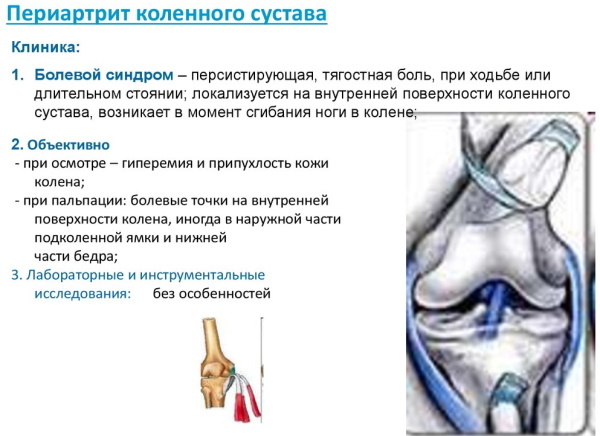 In medicine, primary periarthritis of the knee joint is isolated. The disease occurs independently under the influence of provoking reasons. Secondary periarthritis develops as a complication against the background of other concomitant pathology. In each individual case, characteristic signs appear, with which it is important to immediately go to the hospital.
In medicine, primary periarthritis of the knee joint is isolated. The disease occurs independently under the influence of provoking reasons. Secondary periarthritis develops as a complication against the background of other concomitant pathology. In each individual case, characteristic signs appear, with which it is important to immediately go to the hospital.
Stages and degrees
Inflammation slows down the growth of cartilage tissue, even if the metabolism develops without disturbance. Therefore, the affected area slowly recovers on its own.
The following stages of development of periarthritis of the knee joint are distinguished:
| Name | Description |
| Stage 1 | The inflammation is accompanied by mild painful sensations, morning stiffness. It seems to a person that the joints are numb after a long stay in an uncomfortable position. |
| Stage 2 | The disease is characterized by severe edema. The pain syndrome intensifies, more often after physical exertion. The local temperature rises in the area of the knee joint. |
| Stage 3 | Periarthritis leads to limited mobility. Painful sensations disturb a person when moving and at rest. Even medications do not help reduce discomfort and pain. |

As the inflammatory process progresses in a person, clinical symptoms intensify, which disrupt the usual way of life. It is important not to delay the visit to the orthopedist, but immediately consult, undergo examination and start treatment. Prolonged inflammation without therapy will lead to serious complications, up to and including disability.
Symptoms and Signs
Periarthritis of the knee joint (symptoms and treatment require the consultation of a specialized specialist) is accompanied by pronounced signs that will help the orthopedist to make a preliminary diagnosis, determine the area of localization of the inflammatory process and the degree of damage to others structures.
The clinical picture of the disease depends on the type of pathology:
| Name | Symptoms |
| Acute periarthritis |
|
| Chronic form |
|

The main symptom for any type of periarthritis is pain syndrome. It appears when the position of the affected limb changes, while walking or when bending the leg, and disappears at rest. With the development of a chronic form of inflammation, a person begins to limp, so he takes care of the sore leg and reduces the load on it.
Causes
The knee joint can withstand heavy loads, so it easily lends itself to negative influences from various factors. Inflammation affects not only the articular structures, but also tendons, muscles, ligaments, and the outer bag. The risk category includes professional athletes, the elderly and those who face heavy physical exertion every day.
There are other provoking factors, against the background of which the inflammatory process develops in the area of the knee joint:
- mechanical injury;
- sedentary lifestyle;
- prolonged stay or work in a sitting position;
- hypothermia of the body or directly of the lower extremities;
- heavy load on the knee joint;
- the presence of acute or chronic diseases in humans;
- degenerative-dystrophic changes in the knee area;
- congenital anomalies in the development of the ligamentous apparatus;
- chronic diseases of cartilage and bone structures.
Many abnormalities in the human body provoke the launch of pathological processes, against the background of which periarthritis of the knee joint develops:
- impaired blood circulation in the lower extremities;
- hormonal disorders in the body;
- endocrine system damage;
- the development of diabetes mellitus;
- increased blood viscosity;
- spasms in the blood vessels;
- overweight;
- atherosclerosis.
An orthopedist or surgeon will help determine the root cause of the inflammatory process. It is important at the first sign to immediately visit a specialist and undergo the prescribed examination. The results obtained will help not only to establish an accurate diagnosis, but also to choose the most effective treatment regimen.
Diagnostics
Periarthritis of the knee joint (symptoms and treatment can be determined by an orthopedist or traumatologist) requires complex diagnostics, which will help to establish the area of localization of degenerative-dystrophic processes, the degree tissue damage. It is important to differentiate the disease, since many pathologies are accompanied by similar clinical symptoms (arthrosis, osteoarthritis, rheumatoid arthritis, gout).
Periarthritis of the knee joint helps to identify the following diagnostic measures:
| Name | Description |
| X-ray | The examination can identify injuries or other injuries in the area of the knee joint. |
| Magnetic resonance imaging (MRI) | The most informative examination method, with the help of which the tissues around the knee joint are carefully examined. A three-layer image helps to carefully examine all parts of the affected area and assess their condition (bones, ligaments, menisci, tendons, muscles). |
| General blood analysis | Blood parameters change, which indicates the development of the inflammatory process in the human body. |
| Ultrasound examination (ultrasound) | During the procedure, muscles, tendons, ligaments, and the joint capsule are examined for the development of pathological processes. |
| Intra-articular fluid intake | The study of the synovial fluid is carried out in order to determine the causative agents of the inflammatory process and its extent. |
In rare cases, the patient is additionally prescribed arthroscopy. An examination that provides for a minimally invasive intervention to establish an accurate diagnosis. During the period of exacerbation of the inflammatory process, it is recommended to completely immobilize the affected leg. For this, patients should wear a special bandage.
Treatment methods
Treatment of periarthritis of the knee joint is carried out in a comprehensive manner, taking into account the present symptoms and complaints of the patient. The orthopedic surgeon selects drugs in each case individually, guided by the results obtained after a medical examination. Additionally, patients are advised to attend physiotherapy procedures. If there are no serious medical contraindications, non-traditional methods can be used in combination with traditional drugs.
Drug therapy
Many medications provoke the appearance of side effects, so it is important during therapy to strictly adhere to the prescribed dosage of medications. It is better to refuse self-treatment, since it can cause serious complications and deterioration in health.
Periarthritis of the knee is treated with the following drugs:
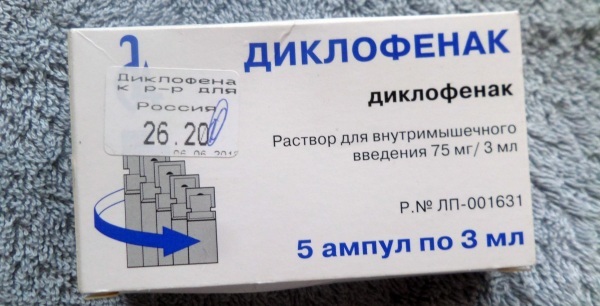
| Drug group | Name | Application |
| Non-steroidal anti-inflammatory drugs (NSAIDs) | Diclofenac, Meloxicam | Patients are prescribed drugs in the form of injections, ointments or tablets. It all depends on the state of the person. In some situations, the orthopedic surgeon combines several drugs at once. The initial adult dosage is 100-150 mg per day. It should be divided into 2-3 doses. The medicine is taken after meals, swallowed whole and washed down with a small amount of liquid. |
| Steroid medications | Prednisolone, Hydrocortisone | It is recommended to divide the daily dosage of the drug into 2-4 doses. The tablets are preferably taken after meals, washed down with plenty of water. Adult patients are prescribed 20-30 mg per day. If necessary or in an emergency, the dosage is increased to 100 mg per day. |
| Analgesics | Paracetamol, Novalgin | The medicine should be swallowed whole and washed down with a sufficient amount of liquid, preferably after a meal in 1-2 hours. The adult dosage depends on the patient's condition and is 500-1000 mg 1-4 times a day. The treatment lasts 3-5 days. |
| Ointments | Fastum, Diklak | Medicines have a local irritating and warming effect, increasing blood flow in the affected area. The ointment is applied in a thin layer of 5-10 cm 1-2 times a day and rubbed into the sore knee with light massage movements. In most cases, therapy lasts 10 days. |
| Chondroprotectors | Structum, Teraflex | Medicines reduce pain, slow down degenerative changes, and prevent cartilage breakdown. The tablets are taken orally, washed down with plenty of water. The adult dosage is 1 capsule of 250 mg 2 times a day or 1 capsule of 500 mg 1 time per day. The course of treatment lasts at least 6 months. |
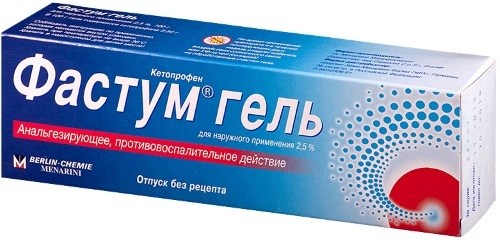
Intra-articular injections with the use of Lidocaine, Novocaine will help to quickly stop severe pain syndrome. Additionally, vitamin and mineral complexes are prescribed, which not only increase the body's resistance to inflammation, but also reduce pain.
Folk remedies
Periarthritis of the knee joint (symptoms and treatment require a comprehensive examination) will help slow down the development of complex methods of therapy. Unconventional methods of healers and healers are best used under the supervision of a specialized specialist. Natural ingredients are safe for the human body, but in some situations they provoke an allergic reaction or individual sensitivity.
Effective recipes for periarthritis of the knee joint:
| Name | Recipe | Application |
| Healing tea | Mix in equal proportions raspberry, lingonberry and black currant leaves. Add the same amount of rose hips. Grind all components well and pour 30 g of the resulting mixture with boiling water (500 ml). Put the finished mass on medium heat and heat for another 15 minutes. Then cool and strain. | The resulting broth is recommended to be consumed before meals 3-4 times a day for 0.5 tbsp. Healing tea not only strengthens the body, but also improves material metabolism, has a positive effect on the state of blood vessels. |
| Red capsicum | Chop and chop 5-7 pcs. red pepper. Pour it with clean vodka or diluted ethyl alcohol. Leave in a dark place at room temperature for 1 month, shake occasionally. | Before use, the resulting tincture should be diluted with water in equal proportions to avoid skin burns. The sore knee is rubbed with the finished medicine. |
| Home ointment | Mix 2-3 young leaves of plantain, dandelion and calendula. Add a medium-sized horseradish leaf and 6-7 chamomile flowers. Mix all components well and add 2 drops of essential oils of juniper, cypress, fir, and wheat germ. Additionally enter 1 tsp. dry mustard, gum turpentine and coarse-crystalline sea salt. The last component is petroleum jelly. It is added in small portions to obtain an ointment. | The prepared ointment at home is rubbed into the affected area of the knee joint 2-3 times a day. |
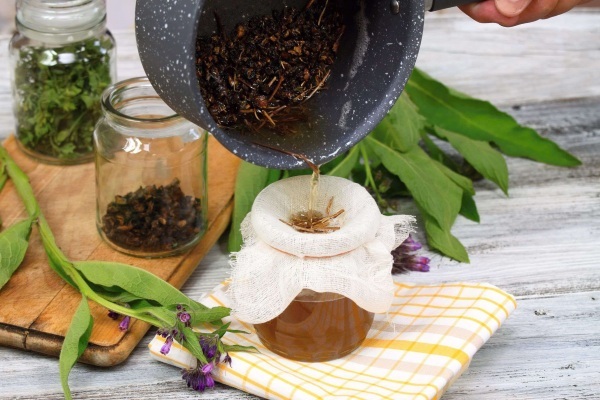
Natural honey is a healing natural remedy. It can be used for compresses on a sore knee and taken internally. The chronic form of periarthritis is treated with the leaves of sweet clover, marshmallow and chamomile. They are used to prepare a decoction, which is used in the form of a compress.
Physiotherapy
Periarthritis of the knee joint (symptoms and treatment of the inflammatory process will be determined by an orthopedist) at the stage of remission is completely eliminated with the use of physiotherapeutic procedures. They enhance the effectiveness of drugs and reduce the symptoms of the inflammatory process. They also help reduce the likelihood of a secondary relapse of the disease.
Patients are advised to attend the following procedures:
| Name | Description |
| Medicinal electrophoresis | The therapy is carried out using a weak electric current, under the influence of which the active components of the drug penetrate directly into the focus of the inflammatory process. |
| Pulse magnetic therapy | The treatment uses a magnetic field. Under its influence, metabolic processes increase in the human body, inflammation and pain syndrome decrease. The development of pathogenic flora also slows down, the elasticity of the blood walls increases, which improves microcirculation.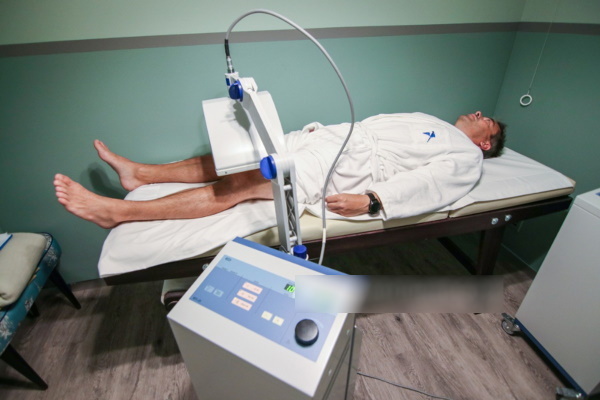
|
| Infrared laser treatment | The therapy is carried out using electromagnetic radiation, which has a positive effect on all processes occurring in the cells of the human body. The general condition of the damaged tissues improves, the level of cholesterol decreases. Infrared laser treatment has anti-inflammatory, anti-edema, antioxidant effects. |
| Hirudotherapy | During the treatment, leeches are used. An alternative method of medicine that helps to remove toxins and toxins from the human body, restore normal functioning of organs and systems, activate protective functions and quickly reduce painful Feel. |
| Acupuncture | Acupuncture is often indicated during the rehabilitation period after drug therapy of the inflammatory process. During the treatment, thin needles are used, which act on the biological active points of the human body. Acupuncture allows you to activate all the working forces of the body. |
During the period of improvement, when the symptoms of acute periarthritis decrease, patients are prescribed ozokerite and paraffin applications. Medicinal mud, radon and hydrogen sulphide baths will help to consolidate the positive result.
Operation
Surgical treatment for patients with periarthritis of the knee joint is indicated in emergency situations or in the event of serious complications. This includes the formed adhesions, contractures, calcifications, which partially or completely block the mobility of the joint.
Potential consequences and complications
Periarthritis of the knee joint without timely therapy against the background of a long course provokes serious degenerative changes in muscles and bone structures. They atrophy, as a result of which the mobility of the lower limb deteriorates. The patient is threatened with disability.
Complications and consequences of periarthritis of the knee joint:
| Name | Description |
| Calcifications are formed | The walls of the periarticular bursa are encapsulated. The resulting calcifications partially or completely reduce the mobility of the limb. |
| Contractures | The limited joint in mobility changes, the tissues contract, their elasticity decreases. |
| Arthrosis, osteoporosis | Pathological processes develop against the background of insufficient nutrition of the surrounding tissues of the knee joint. Bones and ligaments weaken and become fragile, which increases the likelihood of developing other diseases. |
One of the complications of periarthritis of the knee joint is secondary infection. The same goes for the rupture of the affected ligaments and muscles. Complications of the disease depend on the degree of damage to the knee joint and surrounding tissues. Lack of timely therapy increases the risk of dangerous consequences.
The prognosis for periarthritis of the knee joint is favorable if the patient goes to the hospital in a timely manner, underwent examination and prescribed treatment. Otherwise, the symptoms of the inflammatory process will intensify, which indicates the progression of degenerative-dystrophic processes. Without therapy, periarthritis will lead to negative consequences, up to and including disability.
Video about joint periarthritis
What is periarthrosis:



